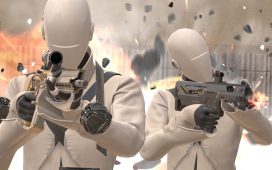
After recently playing a prototype version of Laser Dance, I’ve been trying to wrap my head around what makes it so engaging. And it finally struck me. The game is a manifestation of the kind of simple rules that could turn any ordinary day in my childhood into an exciting adventure.
Immediately I recalled the classic childhood pastime of ‘the floor is lava’, the game where everyone has to pretend that the floor is entirely covered in lava, and touching it means you’ll die (not morbid at all, I know). So you have to climb on your furniture or hop from spot to spot to avoid an untimely doom.
That one simple rule—don’t touch the floor—provided me and my childhood friends hours of fun with nothing more than the room that was around us.
Laser Dance employs a similarly simple rule—don’t touch the laser—and turns it into an entire game that happens right inside your room. It’s actually very much like ‘the floor is lava’, but now the puzzle is three dimensional. And this time it’s not just in your imagination.
The game works by having you place two virtual buttons on opposite sides of your room. Your goal is to move from one button to the other without touching any lasers. But it isn’t just one set of lasers. The demo I played on Quest 3 showed many different ways the lasers could be arranged and sometimes they even moved, forcing me to time my movements just right.
The game is so simple to understand and play that it’s easy to miss the serious technical and design challenges lurking underneath. It feels somehow like each level as been custom-made for your room; that’s because Laser Dance is actually analyzing the shape of your room and customizing each level to fit. Developer Thomas Van Bouwel wrote about how that system works in a Guest Article published last year.
Footage of early Laser Dance gameplay | courtesy Thomas Van Bouwel
And it seems to be doing a great job. When I played the demo I didn’t run into any moments where it felt like I couldn’t find my way to the goal without bumping into any lasers—even if that meant sometimes crawling along the floor to get there! And this was not in the kind of hyper-clean modern rooms you see in Quest 3 ads… this was in my messy workshop space with chairs and things scattered randomly about the floor.
And therein lies much of the magic of Laser Dance. The technical stuff happens behind the scenes, leaving the player focused on one thing, and one thing alone: don’t touch the lasers.
There’s something really compelling about a game like this that so clearly taps into your sense of proprioception (the unconscious awareness of where your limbs are) and thus drives a strong sense of embodiment.
The game uses the latest inside-out body tracking tech from Meta to convincingly track not just your head, but also your hands and arms. So if you hit a laser with your shoulder—that’s on you. And even though the game doesn’t actually track your legs, I found myself diligently stepping over and around the lasers just the same.
And Laser Dance feels like it’s shaping up to be more than just a tech demo. The variety and difficulty of the levels, even at this early stage, makes it clear that it’s designed to be fun and challenging—not just a way to show off Quest 3’s latest and greatest tech.
Laser Dance is one of the most engaging mixed reality experiences I’ve played yet. It’s also one of the first Quest 3 MR experiences that I’m actually excited to show other people because it’s quick and easy to learn, especially because it doesn’t rely on controllers.
Laser Dance is planned for launch later this year.












